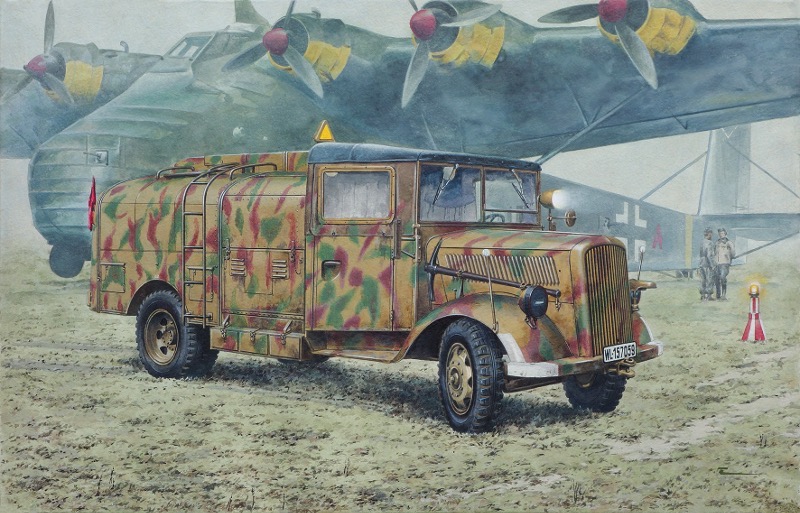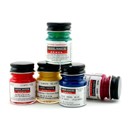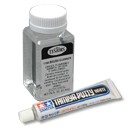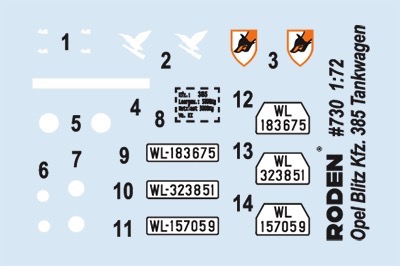

Opel Blitz Kfz.385 Tankwagen
Unassembled plastic model kit
Don't forget building supplies!
In Stock (Ships in 1-3 business days)List price: $20.00
You pay: $14.49
(All prices in U.S. Dollars)

Manufacturer: Roden
Stock Number: ROD 730
Scale: 1/72
View all products of type "Tank Truck"
View all products of type "Opel Blitz"
You pay: $14.49
(All prices in U.S. Dollars)


Manufacturer: Roden
Stock Number: ROD 730
Scale: 1/72
View all products of type "Tank Truck"
View all products of type "Opel Blitz"
This model kit requires assembly. Cement, paint and other construction materials not included unless specifically stated in the description.
Includes markings for:
The first vehicles of this type were produced in early 1941 as by that time the needs of Germany's future participation in war was already clear. The early series refuelers had an open driver's cabin with a tarpaulin covering, just as did the earliest trucks of this type. Later it was decided not to make changes to the machine design, although it was obvious that North Africa would not be the only place these machines would find themselves in. The Flugbetriebsstoff Kessel-Kraftwagens which were operated in the severe conditions of the Russian winter always moved with covered cabins, though it was considered that an open cabin would facilitate the driver's maneuvering on airfields near planes before refueling.
In comparison with the standard trucks the quantity of the Flugbetriebsstoff Kessel-Kraftwagen (Kfz.385) built was quite small (different sources indicate between 300 and 500 refuelers were produced), however in contemporary photos it is possible to see the Kfz.385 near all the main types of fighters and bombers of the Luftwaffe, as well as near large transport planes. Their military service lasted until the end of the war, and even the epochal transition from propeller to jet aircraft saw the continued use of the Flugbetriebsstoff Kessel-Kraftwagen (Kfz.385) - the first jets such as the Me 262 were also refueled by these vehicles.
- Opel Blitz Kfz.385 Tankwagen, (WL-157059), Eastern Front, Odesa airfield, November 1943 - April 1944
- Opel Blitz Kfz.385 Tankwagen, (WL-323851), Germany, summer 1943
- Opel Blitz Kfz.385 Tankwagen, (WL-183675), Sicily, 1942
- Opel Blitz Kfz.385 Tankwagen, Leningrad Front, Hostkino airfield, February 1942
The first vehicles of this type were produced in early 1941 as by that time the needs of Germany's future participation in war was already clear. The early series refuelers had an open driver's cabin with a tarpaulin covering, just as did the earliest trucks of this type. Later it was decided not to make changes to the machine design, although it was obvious that North Africa would not be the only place these machines would find themselves in. The Flugbetriebsstoff Kessel-Kraftwagens which were operated in the severe conditions of the Russian winter always moved with covered cabins, though it was considered that an open cabin would facilitate the driver's maneuvering on airfields near planes before refueling.
In comparison with the standard trucks the quantity of the Flugbetriebsstoff Kessel-Kraftwagen (Kfz.385) built was quite small (different sources indicate between 300 and 500 refuelers were produced), however in contemporary photos it is possible to see the Kfz.385 near all the main types of fighters and bombers of the Luftwaffe, as well as near large transport planes. Their military service lasted until the end of the war, and even the epochal transition from propeller to jet aircraft saw the continued use of the Flugbetriebsstoff Kessel-Kraftwagen (Kfz.385) - the first jets such as the Me 262 were also refueled by these vehicles.

Copyright © 2005-2024 Scale Hobbyist, all rights reserved


















